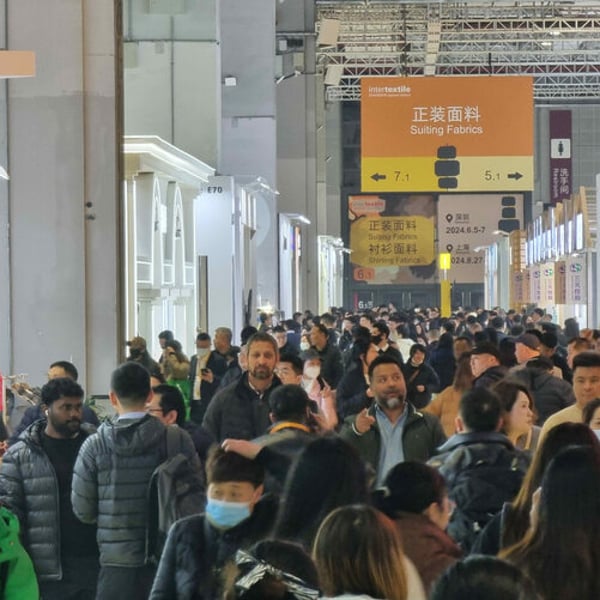Translated by
Nicola Mira
Published
Mar 6, 2024
For three days, Shanghai is the capital of the world’s textiles and apparel industry. The Intertextile trade show opened on March 6, featuring 3,000 fabric producers, and is being held in conjunction with the Chic show with its 1,200 exhibitors. A session that is taking place at a complex juncture for the sector, following a lame year during which consumption slowed down both in the West and in China.
The four-leaf clover layout of Shanghai’s 150,000-square-metre National Exhibition & Convention Centre (NECC), home to the shows, seems extremely apt as a herald of good fortune. For three days, NECC turns into a fully fledged city, complete with 50 or so shops and restaurants, and strategically located close to Hongqiao airport, a hub for domestic flights. Though there are both Asian and European exhibitors at Intertextile, the Shanghai shows primarily feature a cross-section of what China has to offer as the “world’s factory.”
And while Chinese companies are usually reticent about their troubles, they seem no longer inclined to hide the scars left by the last four years. Countless factory closures in 2020, orders by Western clients slashed or cancelled in 2021, then a massive rise in orders in 2022 that maybe heralded a swift recovery, only for hopes to be dashed in 2023. Last year, orders by European and American clients fell in volume and value, dragged down by weaker consumption and inflation. But the sizeable Chinese domestic market could not act as shock absorber, having been hit by a real estate crisis that has led consumers to significantly tighten the purse strings and save money.
Until the end of 2022, Beijing’s zero-Covid policy prevented overseas clients to travel to China to meet their local suppliers. “[The policy was cancelled] too late for clients to come to Intertextile’s March 2023 session, though some did come back in August,” said a sales representative from Wucai Binfen Knitting, adding “we’re hoping to see more of them at this edition, because just sending out samples has its limitations.”
“Encouraging” signs
The first day of Intertextile hinted that the session will be chiefly characterised by the return of regular clients. “We’re mostly seeing existing clients, rather than potential new ones,” said Alex, a representative of Saga, a company that supplies the Inditex group. Kati Shen, head of sales at RF-Tex, a supplier to H&M, Gap, C&A and Columbia, is optimistic about 2024: “We are well-positioned both in the mid-market and high-end segments, so we’re better able to adapt to the [demand] fluctuations experienced by the USA and Europe.”

“The last two years have been tough for all the links in the supply chain,” said Anupam Agrawal, head of the yarn business at Indian giant Indorama, exhibiting at the Yarn Expo show. “But there are encouraging signs in 2024. It will be up to individual producers to stand out from the rest,” he added. An Italian buyer browsing the show’s Beyond Denim section, all fitted out in blue, said he has rarely seen his suppliers being so cautious about their predictions.
Meanwhile, differentiation could be achieved through social and environmental responsibility, and many exhibitors are prominently displaying their certifications. Intertextile has a dedicated trend section on sustainable materials, and a sustainability zone, where exhibitors are showcasing their CSR innovations. The China National Textiles and Apparel Council has gone for a gamified approach, offering visitors the chance to win a sustainably sourced bag or umbrella if they use WeChat to scan QR codes scattered around the various sections dedicated to sustainability.

It remains to be seen how this sustainability drive will influence the products developed by Chinese textiles manufacturers, at a time when the country has been hit by the highest inflation in 15 years. Now that fabric producers at Intertextile are mentioning growing energy costs unprompted, the prospects of the Chinese apparel market (estimated to be worth €370 billion) are being viewed with the same caution as the hoped-for economic recovery in the West.
Copyright © 2024 FashionNetwork.com All rights reserved.







